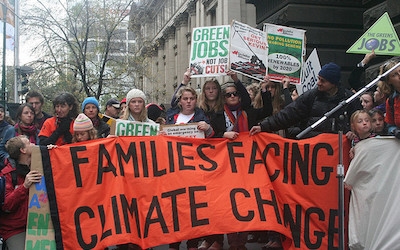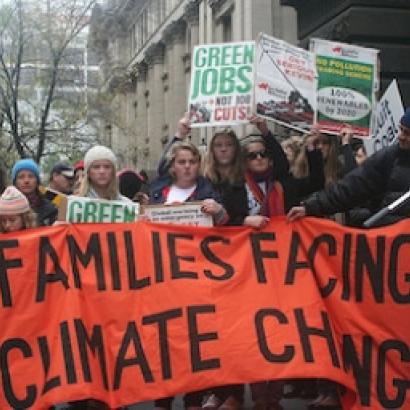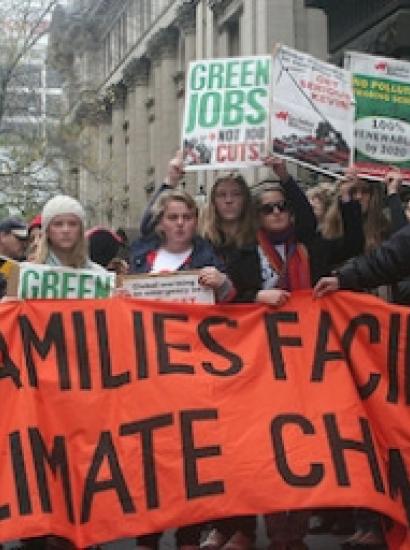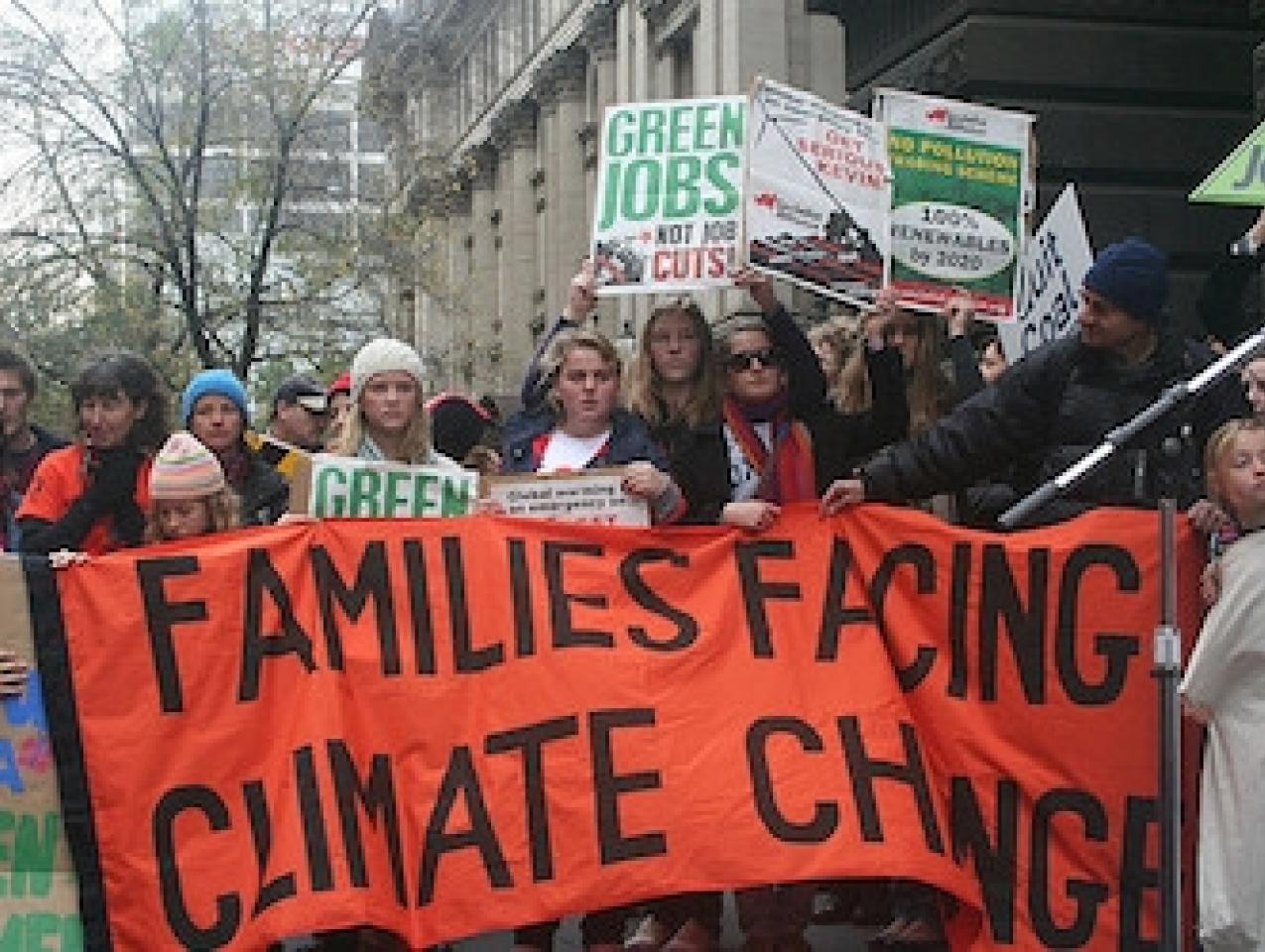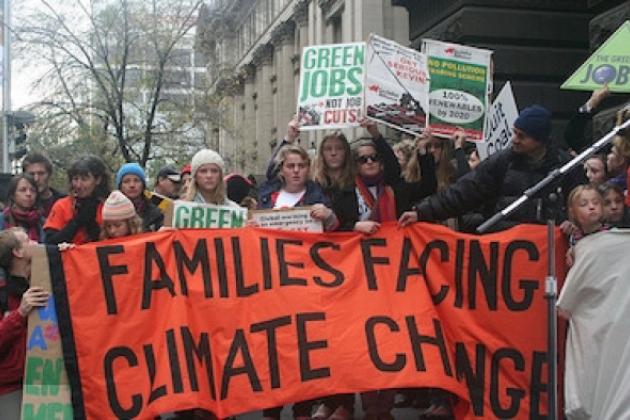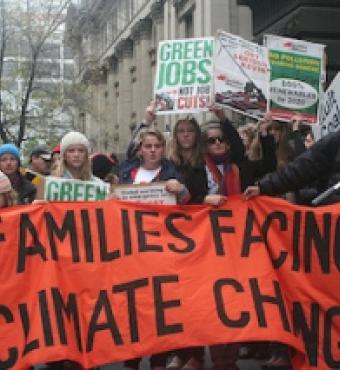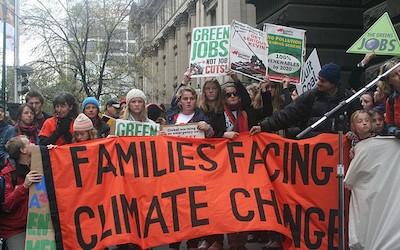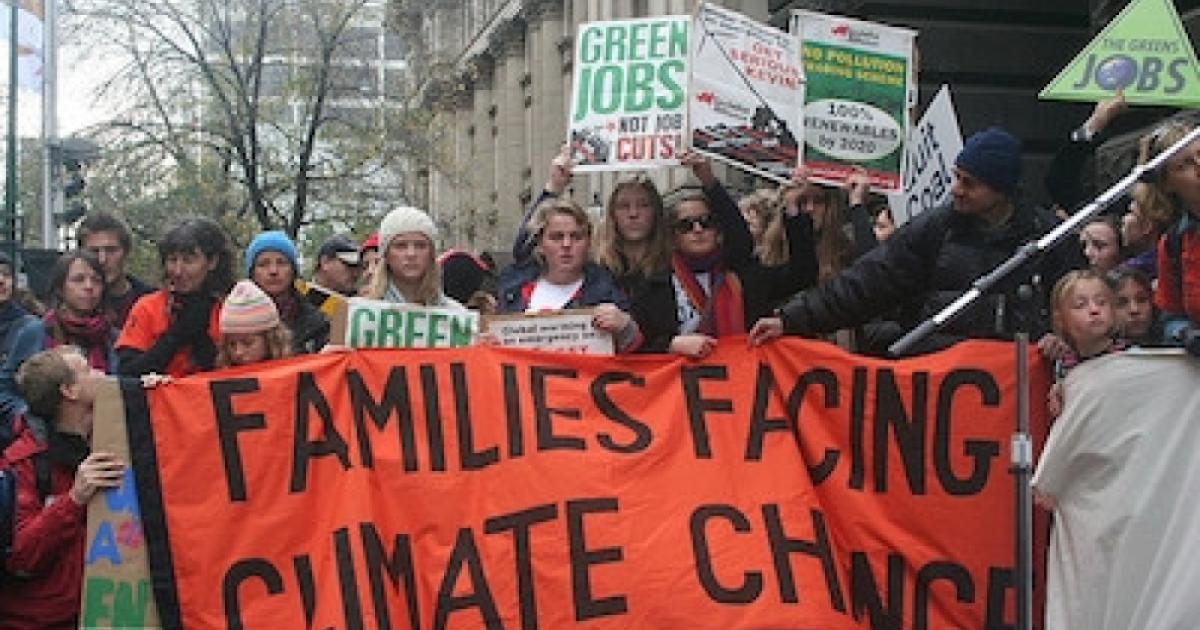- Energy & Environment
In September 2014, the EPA proposed new carbon standards for U.S. power plants that would reduce carbon emissions by 30% by 2030, compared to the levels in 2005. EPA Administrator Gina McCarthy stated that in doing so the United States would turn climate into a business opportunity by spurring innovation and investment through a world-leading clean energy economy.
In November, President Obama and President Xi Jinping of China announced that the United States would emit 26% to 28% less carbon in 2025 than it did in 2005 and China would hold carbon emissions at the level reached in 2030, gradually reducing them thereafter through greater use of clean energy sources. The agreement was called by some a breakthrough between the world’s top two carbon emitters to galvanize efforts to negotiate a new global climate agreement at the United Nations Climate Change Conference, COP21, to be held in Paris in December 2015.
In late November the U.S. Senate along partisan lines defeated a proposal to build the Keystone XL pipeline to bring oil from Canada and the north central plains of the U.S. to the U.S. Gulf Coast. Senator Barbara Boxer of California, one of the strongest opponents of the Keystone XL pipeline, claimed that Alberta oil was especially dirty and a threat to the global climate and populations along its path.
These are heady days for proponents of unilateral energy regulation. There is a rush on climate change regulation within the Obama Administration, California, and the European Union (E.U.), although the October 2014 emissions control plan agreed to by its members was less ambitious than sought by Germany and Nordic countries. In light of this, it is time to introduce some more sobering points to halt this rush. There are important points that should be made far clearer to citizens subject to carbon controls sought by their leaders. Let’s take them one by one.
First, the release of greenhouse gases (GHG) creates a global problem of unknown magnitude. Addressing this global externality requires coordinated action among countries. The actions taken by any single jurisdiction will do little to address the problem unless there is international cooperation. Unilateral action by the U.S., California, the European Union, and any other single entity communicates that these jurisdictions want to assume positions of leadership to jump start new green technologies, but there is little evidence to support the claims made by advocates.
In terms of leadership, the critical question is whether there is any empirical evidence that political leaders and their constituents will adopt and support costly policies when the benefits are not appropriable. That is, any reduction in GHG emissions and associated mitigation of global climate change will be shared worldwide. The costs, however, taken by a single country or state (California) will be born locally. Historically, political leaders in the U.S. and other large countries have taken international leadership positions on costly policies when there are clear, capturable benefits from doing so. For instance, the Marshall Plan is evidence of U.S. international leadership during the early Cold War when the U.S. and western Europeans were confronting a serious threat from the Soviet Union and its allies. The monetary transfers were enormous, but the benefits of free western European countries as allies and trading partners were obvious to most Americans. By contrast, when international policies are costly to a country’s citizens and the benefits are very unclear or broadly spread across all countries, then leadership is neither durable nor effective even in the short run. Consider the recent efforts to mobilize sanctions against Russia following its invasion of the Ukraine. The E.U., with important business ties to Russia and hence potentially high local costs from applying economic penalties, was especially reluctant to take serious action and although some sanctions were implemented, they have been insufficient to importantly change Russia’s plans.
When internal costs are small, then country leadership is sustainable because little is at stake for most citizens. This is not how climate change regulation is likely to unfold, however. Because it will be costly, particularly to large numbers of lower and middle class populations and any benefits will be spread throughout the world, country leadership is not apt to persist until there is more conclusive evidence of offsetting direct country benefits. Those advocating strong unilateral action in California, in the U.S., in the E.U. and elsewhere have not been forthcoming in admitting to their general populations that there is no empirical evidence that leadership will work to thwart the underlying incentive of other countries to free ride. Countries and their citizens may bear very high costs of actions that primarily benefit others. Altruism is unlikely to be a sustainable political strategy for any serious country politician.
Second, political leadership on GHG controls is portrayed as a way of showcasing green, alternative fuels technologies and gaining a first-mover competitive advantage for the state or country. Again, what is the evidence on this assertion? If companies in California, the U.S., or the E.U. invest in new technologies, stimulated by government surpluses and restrictions on carbon fuels, what prevents that technology from being copied by competitors elsewhere?
With a global problem and poorer countries like India, China, and Indonesia required by any international agreement to also switch from fossil fuels, the pressure on U.S. firms to share (give away) the technology will be enormous. There is experience with this pressure in pharmaceuticals, and to the degree that it is effective, the incentives of private companies to invest in costly, uncertain technologies will be undermined. Intellectual property concerns are rarely raised in calls for unilateral climate regulations. Yet, they are absolutely critical.
Moreover, what about production of green technologies, such as solar panels and wind turbines? What competitive advantage is gained from any political jurisdiction, such as California or the U.S. or the E.U. in production and job creation? The evidence on solar panels already is not promising with Chinese producers under-selling those in the U.S. and E.U. with accompanying calls for trade restrictions. Moreover, the evidence from first-mover advantages across most industries within the U.S. is that this advantage is short lived. Competitive advantages are quickly eroded by competitors. It is reasonable to conclude that the U.S. and E.U. will not have sustainable competitive advantages in the manufacturing of green technologies, but the costs of unilateral actions will be long lasting.
So far, assertions by proponents of strong unilateral controls on carbon also have not been forthcoming on this issue. The conditions under which first mover and competitive advantages are achievable for green technologies have not been spelled out, even though these advantages are highlighted. Alternatively, one can imagine serious international trade conflicts as expectations in areas that control carbon emissions are thwarted by global competitors both by copying technologies and production techniques so as to outcompete firms and workers in economies that regulate carbon and by cheating on international agreements, an issue addressed further below. Global trade disruptions will only make the world’s populations poorer and less supportive of any environmental regulations.
Third, the costs of controlling carbon are not spelled out by proponents. Rather, the moral obligations for protecting future generations and disadvantaged populations of less-developed regions of the world are stressed. The serious truth of the matter is that most assessments of climate change indicate that to limit the rise of temperatures to targeted ranges requires that most fossil fuels be left in the ground. There must be a relatively rapid shift from fossil fuels to alternative green technologies by all major carbon emitting economies. This is what underlies the “leadership” arguments of proponents of unilateral climate action. But the costs are likely to be very high. For low-cost carbon fuels to be replaced by higher-cost green technologies, the price of carbon must be raised significantly. Raising the price of carbon to the meet the so-called social cost of carbon, which already is elusive with some estimates ranging from $21 to $266/metric ton of carbon released, is what carbon taxes or tradable emission permits are all about. These are policy instruments for raising fossil fuel prices.
The current experience with the economic and political benefits of the fall in gasoline and natural gas prices from expansion in U.S. oil and gas production in North Dakota and Texas due to hydrologic fracking gives some idea of the costs of a tax that would have the opposite effect. The fall in prices has been effectively a tax cut for lower-income groups in the population who spend more of their incomes than do the more wealthy. Retail sales are up; employment has grown; manufacturing plants previously overseas are moving back to the U.S. These trends especially benefit blue collar workers who otherwise have not participated in the growth of the more technology-based economy stressed by proponents of alternatives to fossil fuels.
Indeed, the U.S. does have a comparative advantage in fossil fuel production and it is an industry that spreads its benefits broadly to some of the more disadvantaged parts of the population. This is in contrast to green technologies where the U.S. has no inherent competitive advantage. A rise in fossil fuel costs via taxes, emission permits, and regulations that limit the use of coal can only serve to undermine these economic gains and hurt the parts of the society that already have struggled. The same political coalition that pushes for climate action also often aligns with higher minimum wages and other interventions. But minimum wage hikes are poor and incomplete substitutes for low energy costs and they add to the overall costs of doing business in this country. There is no transparency from green-technology proponents on the costs of higher energy either.
Fourth, what are the benefits of GHG mitigation? Despite all of the rhetoric, the benefits are surprisingly unclear in terms of magnitude, timing, and distribution across the planet. None of these points are emphasized in calls for carbon controls. Most of the climate-change models used by proponents of action are simulations of possible global patterns. They are based on estimates of current GHG accumulations in the atmosphere, additional emissions, and the potential interaction of GHG with natural systems—weather, hydrological patterns, oceans, and so forth to derive possible climate reactions—higher temperatures, more variable precipitation. From these global simulations, costs of possible climate change are derived by linking predicted temperature increases with environmental conditions and economic activities—agriculture, trade, population growth.
At a global scale these models are obviously highly uncertain, especially because the natural and human reaction to any rising temperatures is so unknowable. If the global models are uncertain, matters are even worse for the regional climate models however. Regional simulations of the interactions among GHG accumulations, natural systems, and human populations are much less precise than are the global ones. Local factors such as cloud cover, topography, population growth rates, migration patterns, urbanization, production technologies, agricultural practices, and other economic activities are extraordinarily difficult to link in predicting reactions to possible higher temperatures. Yet, local effects of any climate change are what matter to most citizens and their political leaders.
If any climate change is beneficial in some places, such as high-latitude countries like Canada, Iceland, or Russia, or is not very harmful due to adaptation, then the motivation for individual countries to bear economic costs to confront a distant problem is reduced. Currently, the debate is so politicized particularly by proponents of action that is difficult to know what evidence is reasonably credible versus what is advocacy. Demonizing those who raise legitimate concerns about bearing high costs to achieve uncertain benefits as “deniers” or being “anti-science” is a convenient tool used by proponents, but it is not a useful way for wading through the complex information that comes from the climate models on the possible costs of climate change across the planet.
Fifth and finally, there is the real global collective action problem. Sovereign countries must cooperate to address GHG emission controls. Leaders will credibly and durably do so only if it is in the interest of their constituencies. This sobering fact also is not emphasized by proponents of action. Is there empirical evidence of any country leaders knowingly adopting policies that make its citizens worse off (bear important costs) when the benefits largely are captured elsewhere and where other countries free ride on the actions taken by those that comply with any international agreement? The answer seems obvious.
Currently, the divide in international negotiations to reach a global treaty largely is between developed countries—the E.U. membership, the U.S., and developing countries, with leaders of the latter demanding that populations in the developed world bear most of the costs of cutting back on carbon. It is understandable that leaders of developing countries, such as China, India, Indonesia, Brazil, and elsewhere want to support the aspirations of their populations to achieve better lives through economic growth. Higher fuel and energy costs are inconsistent with that objective, certainly in the short term and the short term is what matters in local and global politics. Yet, these are some of the most economically vibrant parts of the world. Many developed economies in the E.U. and Japan have stagnant or slow-growing economies. It seems unlikely the citizens of these countries will support costly climate change mitigation policies that make their economies even less competitive with higher energy costs while advantaging developing economies that already are absorbing production and jobs from the developed world. Australia, Japan, and Canada recently have dropped local carbon regulations/taxes or announced that they may not participate in binding international agreements. Russia has followed suit.
It is often argued by proponents that transfer payments be made from rich countries to poorer ones to offset the costs of carbon controls. Recently, President Obama pledged $3 billion to developing countries to help them shift from fossil fuels. Domestic U.S. political jurisdictions—cities, states—would surely like such cash transfusions, but this is only a drop in the bucket as to what would be required to compensate big polluting developing countries like India to participate in global controls on carbon. International agreements are among sovereign countries and enforcement is a huge issue when incentives to comply vary so dramatically worldwide.
A November 21, 2014 New York Times editorial criticized India for its plans to expand coal production so as to provide more energy to its huge population, 25% or more, that has no access to electricity. The editorial urged India to consider more costly green technologies. It is unlikely that these external criticisms have much impact on local politicians who must respond to constituent concerns. More broadly, if sovereign countries decide not to participate in any global climate initiative, what is to be done?
If it is a large country that emits a great deal of GHGs, such as China, India, or even Russia, then noncompliance is an important concern because it can undermine the effectiveness of the global effort. Complying economies must cut back more and the populations involved must bear additional costs if targeted reductions are to be achieved. Proponents often point to carbon tariffs to level the playing field and to insure that noncomplying countries cannot take advantage of lower energy costs in exporting to complying countries.
This is obviously a huge challenge. There are legitimate measurement problems in determining carbon content of imports, and parties are very likely to disagree. The potential for trade protectionism under the guise of treaty enforcement is a reasonable possibility. Given the documented advantages of the recent growth in international trade, the costs of the disruption of trading arrangements due to disputes over compliance and measurement of carbon content could further reduce income and wealth globally and the incentives of all parties to participate in any global agreement.
Trading patterns, particularly among large countries, such as the U.S. and China, are very complex. If some products are found to have excessive carbon content and tariffs are applied, retaliation in other trading areas could arise. Imagine if Chinese or Indian steel is found to be produced in a way that violates climate accords and the U.S. applies tariffs, and the Chinese or Indians respond by cutting airplane imports from Boeing or the Chinese reduce their holdings of U.S. government bonds or purchases of U.S. agricultural commodities.
The point is that trade sanctions are not much of a solution when large countries are involved. Consider once again the apparent resilience of Russia in the face of trade and financial restrictions from the U.S., the E.U. and other countries following its invasion of the Ukraine. The international collective action problem is enormous and the thorny issues at hand are not presented honestly by proponents of climate action.
Where does this leave us? What should we conclude from the actions of the Obama Administration and the European Commission in calls for immediate action to reduce carbon use?
One clear answer is that not much GHG emission mitigation is likely to take place globally in the near term. There is too much uncertainty about the costs and benefits and international collaboration is apt to be very incomplete, despite any claims by country leaders. A second answer is that more attention ought to be placed on adaptation. Adaptation can be taken unilaterally to benefit local populations, and importantly the techniques can be shared without undermining economic competitive advantages. It can help moderate any effects of climate change. Adaptation and other climate actions do not necessary have to be mutually exclusive. Currently, adaptation is handled that way by proponents. But for those concerned about economic welfare and the condition of the environment, more adaption while we learn about costs and benefits makes more sense than an unsustainable rush on climate change regulation.







